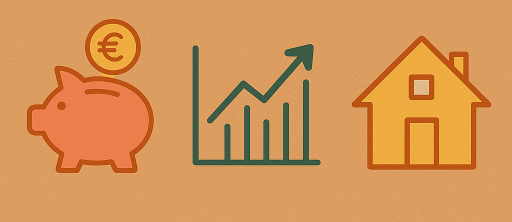3 Money Truths To Fast-Track Your Financial Success
In this article, we go beyond the basics. I’ll show you three important money truths that are rarely explained clearly—and how understanding them can make a big difference in your financial future. Whether you’re budgeting, investing, or buying property, this post is designed to help you think differently and act smarter.
If you’ve been reading personal finance blogs or following financial influencers, you’ve probably heard the same advice over and over: stick to the 50/30/20 rule, invest in the stock market, and buy a home to stop wasting money on rent. These aren’t bad ideas—but they’re not complete either.

Money Truths # 1. The Stock Market: High Returns Come With Real Risk
You might have heard a phrase: “You only lose money if you sell.” But that’s not always true. Some investments don’t recover. Others take decades to break even. To invest successfully, you must understand one money truth above all: the risk/return tradeoff.
In finance, we talk about investments using their risk/return profile. “High risk, high return” sounds exciting—but what is high risk, really? And how do you know when you’ve taken on too much?
High Risk/High Return
What is high return? There are no set percentage ranges. If you are looking to double or triple your investment in the short to medium term, this is considered “high return”, and it means you can also lose a big chunk of your money.
Within the stock market, stock-picking is an example of a high-return investment. It is when you purchase shares of individual companies rather than indices/funds. There are risk/return layers within the stock-picking as well.
All else equal, Emerging markets are riskier than developed ones, and the smaller the company the riskier it is
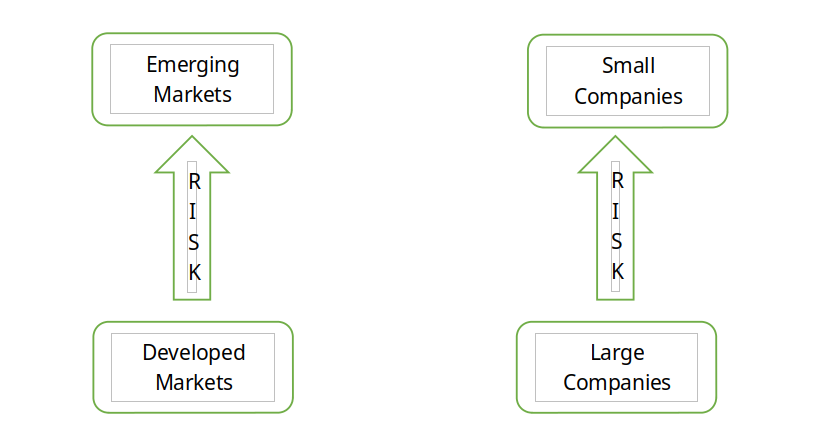
What Is High Risk
High risk means that the investment can go up or down with high magnitude and/or high frequency. It is about how much and how often the price swings from high to low. This is what we call “volatility” in finance.
Crypto assets have high volatility, for example. The graph below shows return from bitcoin vs return from S&P 500 in the past 5 years. Bitcoin outperformed S&P 500 but you can see how much smoother the S&P line is. Investors in S&P 500 probably slept much better than investors in Bitcoin but in this particular time-period, investors in bitcoin became richer.
What if we choose a different period. You purchased bitcoin at the end of 2021 and then needed the money urgently, sold your position at the end of 2023, you lost about 50%! You would have lost only 1.45% from S&P 500.
Disclaimer: This is an illustrative example to showcase how prices move up and down in different periods. It is not a recommendation to buy or sell.
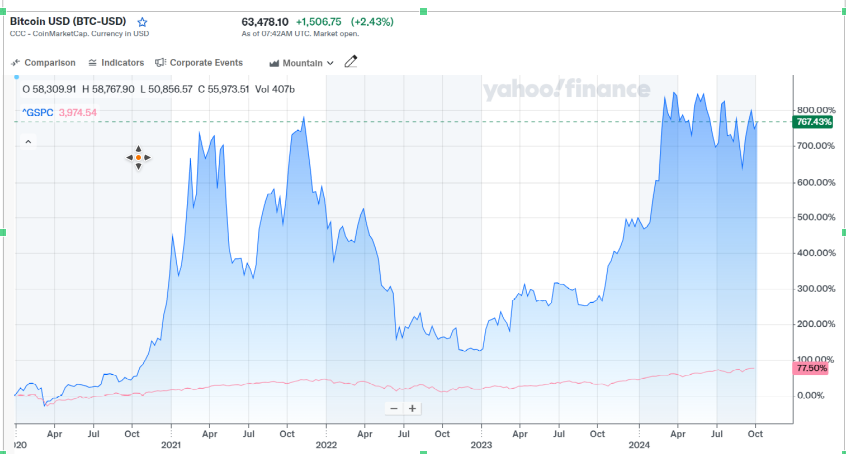
Source: Yahoo Finance (https://finance.yahoo.com/quote/%5EGSPC/)
Waiting May Not Save Us
I once heard “You only lose money if you sell.” This is not true. There are scenarios in which you lose money, and waiting will not help. This is a money truth each experienced investor knows.
Scenario 1
The public company goes bankrupt and the whole equity is wiped out.
Without going into many details, I will explain this scenario in simple terms. When a company cannot pay its creditors and goes bankrupt, all its assets are liquidated, and the proceeds go to cover what it owes. There is a pecking order who gets money first but important for our discussion is that equity-holders (shareholders) get money last, and if there is no money left by the time their turn comes, they get nothing.
You probably expect that small companies have higher risk of failure but from time to time, one of the big ones fails as well. Famous example is Kodak which filed for bankruptcy in 2012. In the process, shareholders were completely wiped out, market cap fell to 0.
Scenario 2
The share price stays low for a prolonged period of time.
Going back to our Kodak example, in November 2013, a restructured Kodak listed its shares again on New York Stock Exchange, the price opened at $26.50/share. For reference, more than 10 years later its share price is around $4.90.
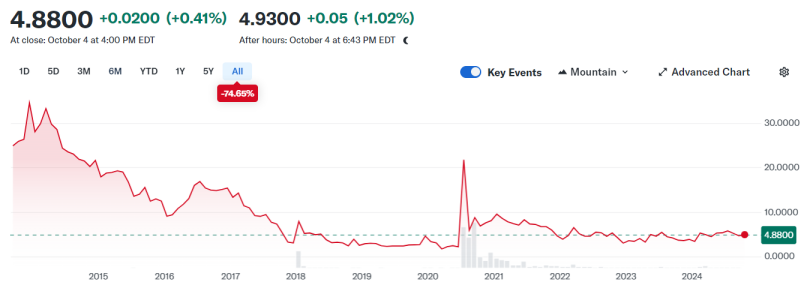
Source: Yahoo Finance (https://finance.yahoo.com/quote/KODK/)
How To Minimize Risk
The aim of this article is not to scare you away from investing on the stock market. It is simply to raise awareness that an investment should be considered in the context of its risk/return profile. High returns usually come with a higher degree of risk, but risk can be lowered if your risk appetite is not high.
The best advice ever is diversification, “do not put all your eggs in one basket”. In short, have different types of assets and choose many of them.
You can buy crypto assets but do not make all your portfolio about crypto. You can invest in shares, bonds, commodities, real estate, etc. When certain assets fall in value, others might rise in value at the same time. Overall, your portfolio will be more stable.
Within the crypto exposure, do not put everything in bitcoin. Same with stocks, invest in S&P 500, then add individual stocks as well if you really want to boost the risk/return profile.
I was trying to find some examples how diversification can lower risk and liked an article on Fidelity’s website (dated Sept 2024). They show 4 investment strategies and their average returns and volatility. This is not meant as a recommendation to invest but purely as an illustration. Past performance is not indicative of future results.
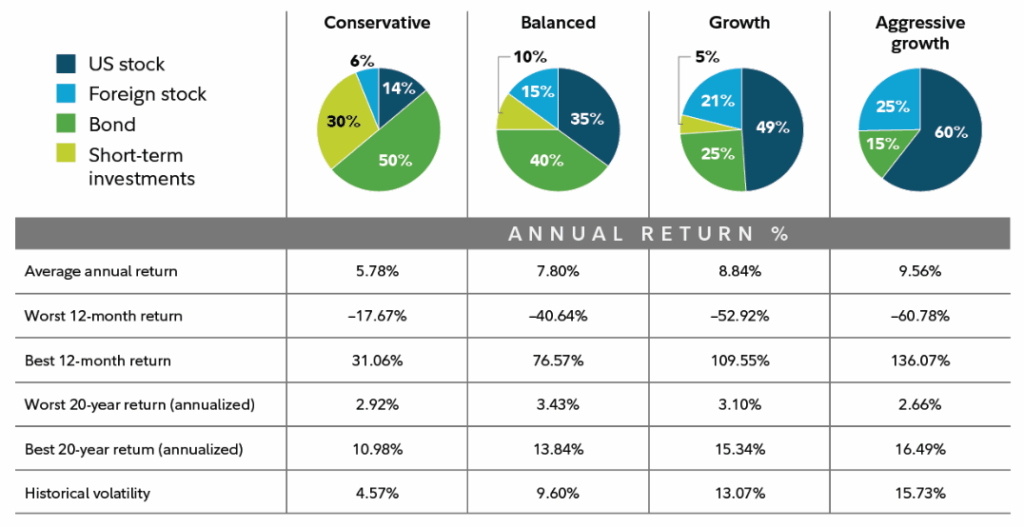
Money Truths # 2. Budgeting: Why the 50/30/20 Rule Might Be Holding You Back
The 50/30/20 rule is one of the most widely shared personal finance rules. It’s simple: 50% of your net income goes to needs, 30% to wants, and 20% to savings. But here’s the problem—your needs and wants are not always tied to your income. In fact, they often don’t grow when your income grows.
What does that mean? If your salary increases but your needs don’t, you have a golden opportunity to supercharge your savings rate—if you resist the urge to inflate your lifestyle.
This might be a difficult money truth to swallow so let me illustrate it with an example.
The Berlin Budget Example
I personally do not follow this rule as my saving rate is higher than 20%, plus I had this gut feeling that 20% is too low, so decided to make an online-research-driven experiment and pretend I am a skilled professional living alone in my twenties in Berlin.
A website called All About Berlin shows EUR 47,784 ( about $ 52,000) gross as the average annual salary in Berlin (https://allaboutberlin.com/guides/salaries-in-germany). I am still young so probably I do not make tons of money, so let us say I earn close to the average and make EUR 2,420 per month. Then I went to a website called Numbeo (https://www.numbeo.com/cost-of-living/) that calculates cost of living and got from there that a single person cost of living in Berlin is EUR 996.6 per month without rent, and this cost covers necessities plus some of what we consider “wants” in the 50/30/20 rule. Average rent for 1-bedroom apartment outside city centre is EUR 853.78.
Now we have all the numbers, let’s do the math. We will consider 2 scenarios:
Scenario 1 “Fixed Needs And Wants”
- Needs and wants are not a percentage of your net income but rather a fixed cost, a sum of money to live comfortably according to your personal preferences.
- Let us say for this experiment that my personal preference is to save as much as possible for my future, I do not need much extra today, and want to live by what the average cost of living is considered.
- With a monthly salary of EUR 2,420 and a monthly cost plus rent of EUR 1850.38 I can save EUR 569.69 per month or 24%.
Scenario 2 “50/30/20 Rule”
- If I followed the 50/30/20 rule instead, I would spend EUR 85.62 per month more, probably on holidays to other European cities. My savings rate will be 20% or EUR 484 per month.
Living in Berlin – typical salary
| Fixed needs and wants | 50/30/20 rule | |
| monthly salary net | 2,420 | 2,420 |
| needs+wants | 997 | 997 |
| extra wants | – | 86 |
| rent | 854 | 854 |
| savings | 570 | 484 |
| savings rate | 24% | 20% |
Source: numbeo.com, allaboutberlin.com
Let us say now that I am not very successful in my career and my salary and savings grow on average just 2% per year but for simplicity, inflation also averages 2% per year so in real terms my monthly contributions do not increase.
I am young though, so I decide to invest with “aggressive growth” and given the Fidelity chart above, I make 10% on average per year in the next 20 years. How much money will I have accumulated in my forties?
I will convert the savings from EUR to USD.
| Fixed needs and wants | 50/30/20 rule | |
| Starting Amount | – | – |
| After | 20 years | 20 years |
| Return Rate | 10% | 10% |
| Compound | annually | annually |
| Additional Contribution | $1,710 | $532 |
| End Balance | $449,436 | $381,877 |
| Starting Amount | $0.00 | $0.00 |
| Total Contributions | $150,175 | $127,601 |
| Total Interest | $299,261 | $254,276 |
Source: www.calculator.net annual compounding
After 20 years I will have saved $449,436 or $67,559 more compared to the 50/30/20 rule.
You can argue that over 20 years, $67,559 are not worth it and you would prefer to spend this roughly $100 extra per month to travel. 20% savings rate does not seem a bad outcome and with discipline and consistency I end up with $381,877 despite having a modest salary my whole career.
This amount is absolutely not enough for me to retire at 40 but given that Germany is a relatively social country, I will most likely have a comfortable lifestyle in my late sixties consisting of my government pension and supplemental savings.
What If My Salary Was Higher?
Let us do absolutely the same calculations but this time I am a high skilled worked with a very successful career.
- My starting salary in my twenties is gross €63,533 ($70,006)
- I am raising my salary by 5% (3% above inflation each year)
- I invest in the aggressive growth fund and get 10% return from it.
Now I am making 3,407 per month or 40% more!
The 50/30/20 rule expects me to have 875.22 EUR ($937) per month in extra wants. Maybe I buy a nicer car, live in a bigger apartment, go to exotic places for vacations.
If I stick to a more frugal lifestyle, however, I will be saving 46% of my net income or more than two times more!!
| Fixed needs and wants | 50/30/20 rule | |
| monthly salary net | 3,407 | 3,407 |
| needs+wants | 997 | 997 |
| extra wants | – | 875 |
| rent | 854 | 854 |
| savings | 1,557 | 681 |
| savings rate | 46% | 20% |
Let us see what happens with my savings after 20 years.
| Fixed needs and wants | 50/30/20 rule | |
| Starting Amount | – | – |
| After | 20 years | 20 years |
| Return Rate | 13.00% | 13.00% |
| Compound | annually | annually |
| Additional Contribution | $1,710 | $749 |
| End Balance | $1,757,764 | $769,450 |
| Starting Amount | $0.00 | $0.00 |
| Total Contributions | $410,388 | $179,645 |
| Total Interest | $1,347,376 | $589,805 |
Below is a bonus money truth that urges you to focus on your Earnings.
Bonus Money Truths
Earnings Play A Big Role In Saved Amounts
Lesson 1
First thing we notice that with both budgets if I earn well in my career, save something, and invest it with high risk/return but diversified strategy for a very long period, I am likely to end up with quite substantial wealth in my forties.
Lesson 2
You cannot retire in your forties if you earn a low salary. You can still save enough to supplement your retirement but if you want to reach your financial freedom earlier, you need to focus on your earnings and boost them as early as possible in your professional career.
Your Needs Are Fixed Not Variable Costs
According to the 50/30/20 budgeting rule, necessities and wants are fixed at 50% and 30% (total 80%) of our after-tax income.
For many upper middle class earners necessities-spending might be well under 50% of their earnings, while for those with lower income, they may be higher than 50%. If our earnings grow more than inflation, necessities do not change, you still need the same things to cover your basic needs and probably you have the same wants while the 50/30/20 rule encourages you to spend more.
In my Berlin example, this is evident. If I did not care about expensive cars and luxurious holidays but preferred to stick to my frugal budget in exchange for early retirement, I could have retired in my forties with $1,757,764 worth of investments (a big “if” here – if history repeats itself and I get this 13% inflation-adjusted return annually). This is a life-changing amount of savings I would have never achieved following the 50/30/20 rule.
To read a summary of this money truth plus find out about budgeting alternatives, check this article: https://smartypurse.com/why-the-50-30-20-budgeting-rule-doesnt-fit-everyone/
For more budgeting insights, definitely read: https://smartypurse.com/budgeting-basics-how-to-build-savings-and-grow-income/
Money Truths # 3. Real Estate: Buying a Home As An Investment
Most online budget templates list your mortgage as an expense. But money truth 3 reveals why not all of it is. The principal part of your mortgage is actually a form of investment—it builds equity in your home. This is fundamentally different from rent, which is 100% an expense.
Understanding this shift in mindset can change how you calculate your true savings rate. Every principal payment is a deposit into your own asset column, and it matters.
What Goes Into Our Mortgage Payment
Usually, each mortgage payment consists of two major parts – interest payment and principal repayment.
Mortgage Payment = Interest + Principal + Other (insurance, taxes)
- Interest payment can be classified as just an expense and can go to the monthly cost buckets in your budget
- Principal payment, however is an investment and should go to your monthly savings bucket
Interest Payment: what you pay to the bank for the money it gave you to purchase the property
Principal Payment: reduces the total amount of money you owe to the bank and increases your equity (the percentage of the property that you own)
It is important psychologically to understand that when you make a property purchase, it is an investment decision, it does not matter whether you plan to live there or not.
If you rent your home, your rent payment is an expense and no investment because you pay to be given the right to live in a particular place for a month. Once the month ends, this right ends and you have to pay rent again. Your assets do not increase as a result of this payment.
Next time you calculate your savings rate and you have a mortgage, do not forget to put at least the principal part of the monthly mortgage payment into savings and investments and then calculate them as a percentage of your net income.
Final Thoughts On Money Truths
Build Wealth With Eyes Wide Open
These three money truths—real investment risk, budget flexibility, and mortgage equity—can dramatically reshape how you manage your money. They’re not about abandoning everything you’ve learned but about refining it.
Want to be happy, rich, and free? Don’t just follow rules. Understand what’s behind them. Challenge popular advice, think long-term, and make your plan work for your life—not someone else’s checklist.

